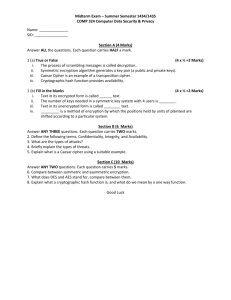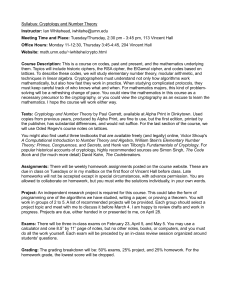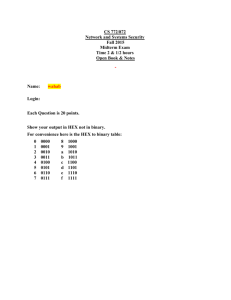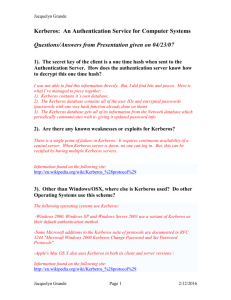2013
advertisement
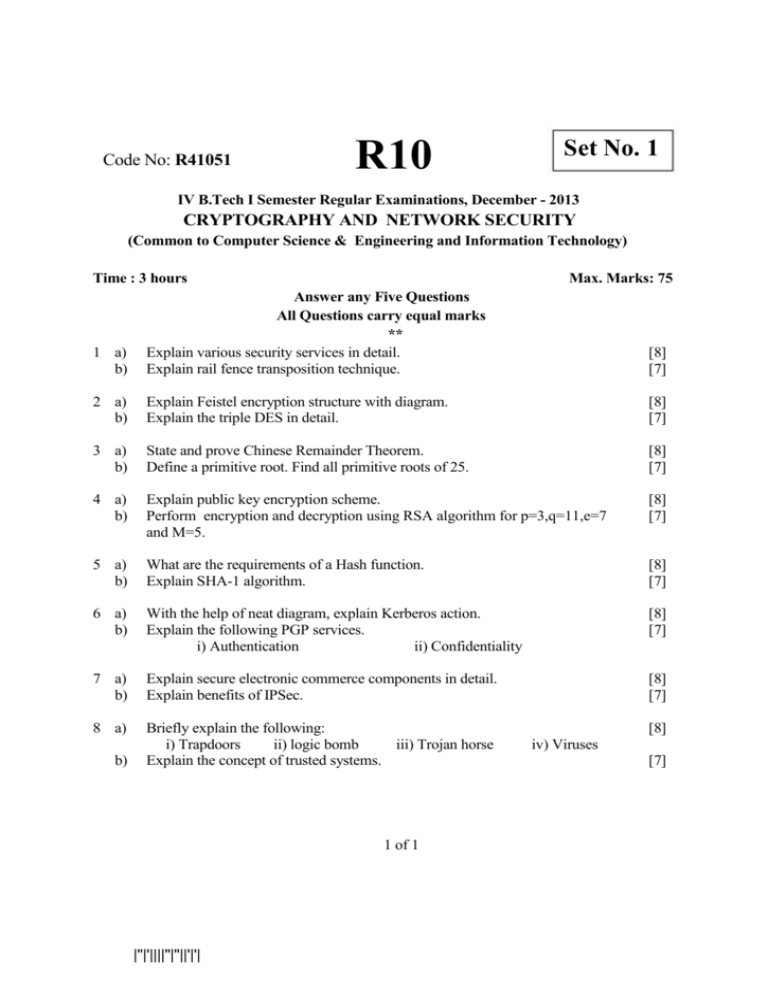
Code No: R41051 R10 Set No. 1 IV B.Tech I Semester Regular Examinations, December - 2013 CRYPTOGRAPHY AND NETWORK SECURITY (Common to Computer Science & Engineering and Information Technology) Time : 3 hours Max. Marks: 75 1 a) b) Answer any Five Questions All Questions carry equal marks ** Explain various security services in detail. Explain rail fence transposition technique. [8] [7] 2 a) b) Explain Feistel encryption structure with diagram. Explain the triple DES in detail. [8] [7] 3 a) b) State and prove Chinese Remainder Theorem. Define a primitive root. Find all primitive roots of 25. [8] [7] 4 a) b) Explain public key encryption scheme. Perform encryption and decryption using RSA algorithm for p=3,q=11,e=7 and M=5. [8] [7] 5 a) b) What are the requirements of a Hash function. Explain SHA-1 algorithm. [8] [7] 6 a) b) With the help of neat diagram, explain Kerberos action. Explain the following PGP services. i) Authentication ii) Confidentiality [8] [7] 7 a) b) Explain secure electronic commerce components in detail. Explain benefits of IPSec. [8] [7] 8 a) Briefly explain the following: i) Trapdoors ii) logic bomb iii) Trojan horse Explain the concept of trusted systems. [8] b) 1 of 1 |''|'||||''|''||'|'| iv) Viruses [7] Code No: R41051 R10 Set No. 2 IV B.Tech I Semester Regular Examinations, December - 2013 CRYPTOGRAPHY AND NETWORK SECURITY (Common to Computer Science & Engineering and Information Technology) Time : 3 hours Max. Marks: 75 1 a) b) Answer any Five Questions All Questions carry equal marks ** Explain various kinds of security mechanisms in detail. Explain monoalphabetic cipher in detail. [8] [7] 2 a) b) Explain the DES encryption algorithm. Explain the strength of the DES. [8] [7] 3 a) b) Define Euler’s Totient function. Determine ¢(37) and ¢(35). Use Fermat’s theorem to find a number x between 0 and 28 with x85 congruent to 6 modulo 35. [8] [7] 4 a) b) Explain public key cryptosystem for secrecy and authentication. Explain Deffie-Hellman key exchange. [8] [7] 5 a) b) Explain MD5 in detail. Explain Simple Hash Function. [8] [7] 6 a) b) Explain X.509 Authentication Services. Describe S/MIME. [8] [7] 7 a) b) Explain the SSL Record Protocol. Explain Web Security threats. [8] [7] 8 a) b) Explain password selection procedure in detail. Explain the capabilities and limitations of firewalls. [8] [7] 1 of 1 |''|'||||''|''||'|'| Code No: R41051 R10 Set No. 3 IV B.Tech I Semester Regular Examinations, December - 2013 CRYPTOGRAPHY AND NETWORK SECURITY (Common to Computer Science & Engineering and Information Technology) Time : 3 hours Max. Marks: 75 1 a) b) Answer any Five Questions All Questions carry equal marks ** Explain the symmetric key encryption model. Explain Caesar Cipher in detail. [8] [7] 2 a) b) Explain block cipher design principles in detail. Explain single round of DES. [8] [7] 3 a) b) State and prove Euler’s theorem. Use Euler’s theorem to find a number a between 0 and 9 such that a is congruent to 71000 modulo 10. [8] [7] 4 a) b) What are the principal elements of a public key cryptosystem? Explain. In a public key system using RSA, you intercept the cipher text C=10 sent to a user whose public key is e=5, n= 35. What is the plain text M? [8] [7] 5 a) b) What is a MAC? Explain message authentication using MAC. Explain RIPEMD-160 in detail. [8] [7] 6 a) b) Explain Kerberos version 4 message exchange. Briefly explain the PGP services. [8] [7] 7 a) b) Describe IP Security. Explain IPSec ESP format. [8] [7] 8 a) b) Explain various approaches to Intrusion Detection. What is a firewall? Explain packet filter router. [8] [7] 1 of 1 |''|'||||''|''||'|'| Code No: R41051 R10 Set No. 4 IV B.Tech I Semester Regular Examinations, December - 2013 CRYPTOGRAPHY AND NETWORK SECURITY (Common to Computer Science & Engineering and Information Technology) Time : 3 hours Max. Marks: 75 1 a) b) Answer any Five Questions All Questions carry equal marks ** Explain various security attacks in detail. Explain the model of conventional crypto system. [8] [7] 2 a) b) Explain block cipher modes of operations. Explain CAST-128 cipher. [8] [7] 3 a) b) State and Prove Fermat’s theorem. Use Fermat’s theorem to find a number x between 0 and 28 with x85 congruent to 6 modulo 29. [8] [7] 4 a) b) Explain RSA algorithm in detail. Perform encryption and decryption using RSA algorithm for p=5,q=11,e=3 and M=9. [8] [7] 5 a) b) Compare the principal characteristics of MD5,SHA-1,and RIPEMD-160. What is a digital signature? Explain this using public key algorithm. [8] [7] 6 a) b) What is Kerberos? What are the requirements of a Kerberos? Explain the limitations of SMTP/822 scheme. [8] [7] 7 a) b) Explain the IPSec Authentication Header fields with diagram. Explain the payment process supported in SET. [8] [7] 8 a) b) Describe different classes of Intruders. Explain malicious programs. [8] [7] 1 of 1 |''|'||||''|''||'|'|


